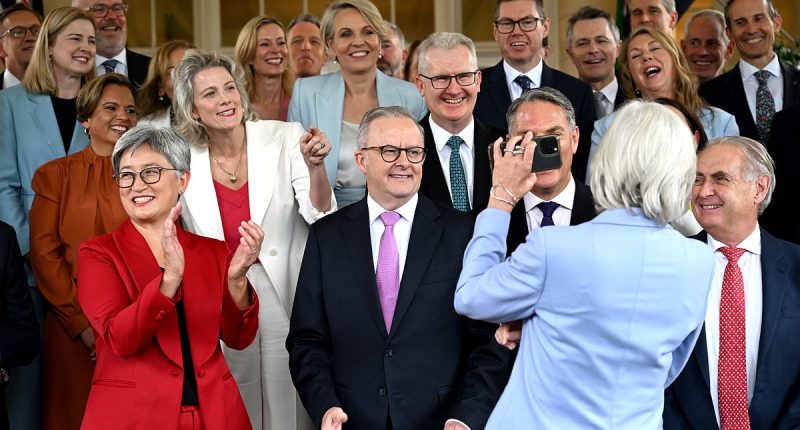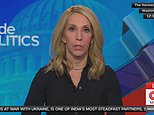Share this @internewscast.com
Australia’s highest-ranking politicians are among the top one per cent of income earners in the country and earn more than leaders in many other comparable democracies.
This has led many people to suggest that politicians’ salaries should be performance-based, with pay cuts applied when they fail to meet their goals
Anthony Albanese earns $607,516 a year, placing him well above other world leaders. His salary is significantly higher than that of UK Prime Minister Keir Starmer, who earns $354,988, and more than Canada’s newly elected leader Mark Carney, who is paid $466,835.
Former Liberal Democrats senator David Leyonhjelm, a libertarian campaigning for smaller government, said Australia’s high pay for politicians produced careerists without life experience outside politics.
‘It turns politics in Australia into a career, a well-paid career,’ he told Daily Mail Australia.
‘I don’t think taxpayers get good value for money but the big thing is that many of the incumbents in those roles can’t do as well outside of politics so they have an additional incentive to hold on to their jobs, hold on to their positions in order not to lose the benefits.
‘We should treat a political role as a temporary position no matter who you are.’

Australia’s most senior politicians are among the top one per cent of income earners and are better paid than their counterparts in other similar democracies

Prime Minister Anthony Albanese earns $607,516 a year, placing him well above other world leaders.
But Warren Snowdon, a former federal Labor minister who was in Parliament for 33 years, said politicians work hard and deserve the money.
‘I won’t comment on the money but I think it’s a fallacy they don’t work hard,’ he told Daily Mail Australia.
‘I don’t know of one member of Parliament that doesn’t work hard.
‘In my own case, I was in the Parliament for almost 33 years and for most of that time, I was at home, on average, eight nights a month, if you exclude the Christmas period.
‘I had to travel inside the electorate which was 1.3million square kilometres, very diverse communities; you can’t be seeing yourself as someone who’s an absent member.’
But Mr Leyonhjelm, who was in the Senate for five years, said too many politicians were addicted to the pay and the perks.
‘I subscribe to the latter view that you’re not in it for the money, it’s not a career and you should have a life before you go into politics, you should have a life after you come out of politics so that you don’t lose touch with what you’re there for and the people you represent,’ he said.
‘You can get into a philosophical argument here – is politics a profession, a calling or should it be people who spend a few years serving the public and go back to a normal life?’

Former Liberal Democrats senator David Leyonhjelm, a libertarian campaigning for smaller government, said Australia’s high pay for politicians, by international standards, produced careerists without life experience outside politics

But Warren Snowdon (second left), a former federal Labor minister who was in Parliament for 33 years representing a vast Northern Territory electorate, said he had constituents spread over 1.3million square kilometres, and portfolio responsibilities
Australia’s most five senior ministers, below the PM, are still among the top one per cent of income earners.
Deputy Prime Minister Richard Marles earns $479,003 while Treasurer Jim Chalmers and Foreign Minister Penny Wong are both on $438,113.
The next rung down, Finance Minister Katy Gallagher and Home Affairs Minister Tony Burke are on $408,905.
Anyone earning $421,936 or more is among the top 0.8 per cent of income earners, tax office figures show.
Then there are 17 other Cabinet ministers earning $403,064, including ministers with new portfolios like Tanya Plibersek (Social Services), Michelle Rowland (Attorney-General), Amanda Rishworth (Employment), Tim Ayres (Industry) and its youngest member, 39-year-old Anika Wells (Communications).
In the outer ministry, there are seven MPs earning $368,015 including 38-year-old Sam Rae (Aged Care and Seniors), Daniel Mulino (Assistant Treasurer and Financial Services) and Jess Walsh (Early Childhood Education and Youth).
Then there are a dozen assistant ministers earning $292,075 including former Tasmanian Opposition Leader Rebecca White (Health and Aged Care), economist Andrew Charlton (Cabinet secretary and Science), and former union leader Ged Kearney (Social Services and Prevention of Family Violence).
Even the most junior ministers are among Australia’s top 1.5 per cent of income earners while backbenchers on a $233,660 base salary are among the top 2.3 per cent.

Australia’s most five senior ministers, below the PM, are still among the top one per cent of income earners. Deputy Prime Minister Richard Marles earns $479,003 while Treasurer Jim Chalmers (left with Governor-General Sam Mostyn) and Foreign Minister Penny Wong are both on $438,113
While Australia’s most senior politicians are well paid by international standards, their remuneration packages are only a small fraction of what Australia’s top bureaucrats get.
‘It’s high by international standards, it’s low by bureaucratic standards,’ Mr Leyonhjelm said.
‘So then the argument becomes – “Should the Prime Minister be paid more or less than the bureaucrats who are basically at his bidding?”‘
Reserve Bank of Australia Governor Michele Bullock is on a total remuneration of $1.057million from a base salary of $811,108.
Treasury Secretary Steven Kennedy is paid $959,257, on top of a base salary of $816,296.
But corporate chief executives are paid considerably more than Cabinet ministers or departmental bosses.
Commonwealth Bank CEO Matt Comyn is on $8.977million with bonuses, on top of his base salary of $2.5million.
Thousands of Aussies have still called for politician’s pay to be based on perfomance.
‘Imagine if they got paid on performance,’ one said.
‘Results based remuneration is the most appropriate form of remuneration for politician,’ another added.
‘It should be performance based – a huge deduction is warranted,’ a third declared.





